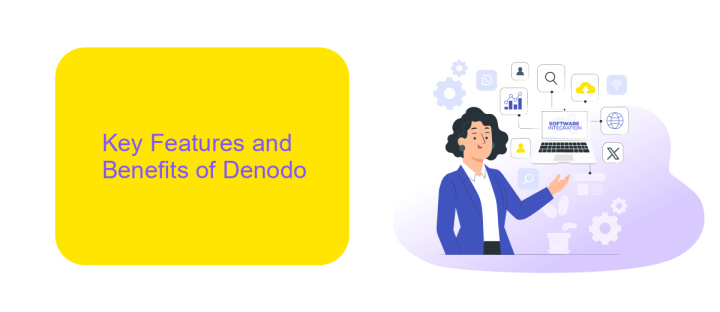Denodo Data Integration
Denodo Data Integration is a cutting-edge platform that revolutionizes how organizations manage and utilize their data. By providing a unified, real-time view of disparate data sources, Denodo empowers businesses to make informed decisions swiftly and efficiently. This article explores the key features, benefits, and use cases of Denodo Data Integration, highlighting how it enhances data accessibility, agility, and governance in today’s fast-paced digital landscape.
Introduction to Denodo Data Virtualization
Denodo Data Virtualization is a cutting-edge technology that simplifies data access and integration across diverse sources without the need for data replication. By creating a unified data layer, it enables organizations to access, manage, and deliver data in real-time, enhancing decision-making and operational efficiency. This approach addresses the complexities of modern data environments, where data is scattered across multiple systems and formats.
- Seamless integration of heterogeneous data sources.
- Real-time data access and delivery.
- Reduction in data replication and storage costs.
- Enhanced data governance and security.
- Improved agility and time-to-insight.
With Denodo Data Virtualization, businesses can overcome traditional data silos and achieve a more agile data architecture. This technology not only reduces the time and cost associated with data integration but also ensures that users have access to the most current and accurate data. As a result, organizations can respond more swiftly to market changes and drive innovation by leveraging data as a strategic asset.
Key Features and Benefits of Denodo

Denodo offers a robust data integration platform that excels in virtualizing and managing data across diverse sources. One of its key features is real-time data access, which allows users to obtain up-to-date information without the need for data replication. This ensures efficiency and reduces storage costs. Denodo's platform is highly scalable, accommodating the growing data needs of businesses. It also supports a wide array of data sources, including cloud, on-premises, and hybrid environments, providing flexibility and adaptability to changing IT landscapes.
The intuitive interface of Denodo simplifies the process of data integration, making it accessible to both technical and non-technical users. With its advanced security features, organizations can ensure data privacy and compliance with regulations. Additionally, Denodo's platform can be seamlessly integrated with services like ApiX-Drive, which further streamlines the process of connecting various applications and automating workflows. This enhances operational efficiency and allows businesses to focus on strategic initiatives rather than technical complexities.
Use Cases and Real-World Examples

Denodo Data Integration is a powerful tool that addresses diverse business needs across industries. Its ability to provide real-time data access and integration without physical data movement makes it invaluable for modern enterprises. Organizations leverage Denodo to enhance decision-making, streamline operations, and improve customer experiences.
1. Financial Services: Banks and financial institutions utilize Denodo to integrate data from disparate systems, enabling comprehensive risk analysis and compliance reporting.
2. Healthcare: Healthcare providers use Denodo to unify patient data across various systems, ensuring a holistic view for better patient care and operational efficiency.
3. Retail: Retailers implement Denodo to merge data from online and offline channels, optimizing inventory management and personalizing customer interactions.
4. Telecommunications: Telecom companies employ Denodo to consolidate customer data, enhancing service delivery and reducing churn rates.
In each of these cases, Denodo's data virtualization platform facilitates seamless integration, empowering organizations to harness the full potential of their data assets. By eliminating data silos and enabling real-time insights, Denodo supports strategic initiatives and drives competitive advantage. Its versatility and scalability make it a preferred choice for businesses aiming to thrive in a data-driven world.
Denodo Architecture and Components

The Denodo Platform is renowned for its robust architecture, designed to facilitate seamless data integration across diverse sources. At its core, the platform operates on a logical data warehouse concept, enabling real-time data access without the need for physical data movement. This architecture ensures that businesses can leverage their existing data assets efficiently, providing a unified view for analytics and decision-making.
Denodo's architecture is composed of several integral components that work in harmony to deliver high-performance data virtualization. These components are designed to be scalable, ensuring that the platform can handle increasing data volumes and complex queries with ease. The modular nature of Denodo's architecture allows organizations to customize their data integration solutions according to specific business needs.
- Denodo Server: The core engine that processes queries and manages data sources.
- Design Studio: A graphical interface for modeling and managing data views.
- Scheduler: A tool for automating data refresh and synchronization tasks.
- Solution Manager: Facilitates deployment and monitoring of Denodo environments.
By integrating these components, Denodo provides a comprehensive platform that supports a wide range of data integration scenarios. This flexibility and scalability make it an ideal choice for organizations looking to enhance their data strategy and drive innovation through data-driven insights.
Comparison with Traditional Data Integration Approaches
Denodo's data integration approach contrasts sharply with traditional methods by offering a virtualized layer that eliminates the need for physical data consolidation. Traditional data integration often involves ETL processes, which can be time-consuming and resource-intensive, requiring data to be extracted, transformed, and loaded into a centralized repository. This not only delays data availability but also increases storage costs and complexity. Denodo, on the other hand, uses data virtualization to provide real-time access to data across multiple sources without moving it, thereby reducing latency and enhancing agility.
Moreover, Denodo's platform facilitates seamless integration with modern cloud services and APIs, offering a more flexible and scalable solution compared to traditional systems. Tools like ApiX-Drive can complement this by automating data flows between various applications and services, further streamlining integration processes. This synergy allows businesses to quickly adapt to changing data landscapes, ensuring timely and accurate insights. Overall, Denodo's approach provides a more efficient and cost-effective alternative to traditional data integration, aligning with the needs of modern enterprises seeking agility and real-time data access.
FAQ
What is Denodo Data Integration, and how does it work?
What are the key benefits of using Denodo for data integration?
How does Denodo ensure data security and compliance?
Can Denodo integrate with cloud-based data sources?
How can businesses automate data integration processes with Denodo?
Time is the most valuable resource in today's business realities. By eliminating the routine from work processes, you will get more opportunities to implement the most daring plans and ideas. Choose – you can continue to waste time, money and nerves on inefficient solutions, or you can use ApiX-Drive, automating work processes and achieving results with minimal investment of money, effort and human resources.

